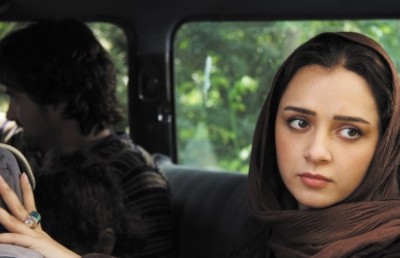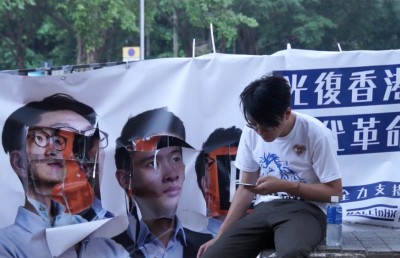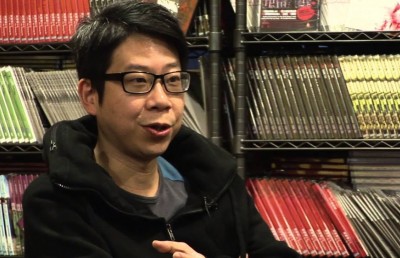Wong Kar-wai’s In the Mood for Love (2000): Postmodern Melodrama

Wong Kar-wai’s In the Mood for Love is a romance melodrama in the Chinese form of the genre. Specifically, it is a Chinese melodrama known as wenyi pian, a genre akin to the American soap opera but culturally produced for the Chinese society (Teo 3).
In the Mood for Love can be considered as a postmodern modification of the old Chinese melodrama and as such, it is a film that deals heavily on times past and nostalgia; and by following such a train of thought, it is possible to explain Wong’s film as a dream of China, a “dream epoch.” Once the dream motif is established as the basis for the underlying structure of the film, then it is reasonable to approach it critically as a film of oneiric origins. One such film is Alain Resnais’ Last Year at Marienbad (1961) which was analyzed by Bordwell and Thompson (+Film Art_, Bordwell & Thompson 391). Quoting their work: “Marienbad creates its ambiguity through contradictions on many different levels: the spatial, the temporal, the causal. Within the same shot, impossible juxtapositions may occur in the mise-en-scene.” In our case, the evaluative criterion becomes an argument, which takes the position that In the Mood for Love is a film that mostly consists of sequences of “time-images,” optical-sound situations that coexist both in the past and present (Deleuze 1).
From this point of view, In the Mood for Love is a postmodern melodrama set in the 1960’s and it creates its ambiguities in manifold allusions to memory, time and place. Like Last Year at Marienbad, Wong’s film is rooted in the dynamics of subjective memory and desire; where an emotional craving exists, a psychological appetite that cannot be satisfied. The “mood melodrama” is an appropriate metaphor for the 1960’s and the film’s Chinese title, Huayang Nianhua, is directly translated as “those wonderful varied years,” suggesting an age of bygone elegance and nostalgia. Moreover, it also means “Full Bloom,” an association that Wong capitalizes on when he scripts the film with a 1940’s Chinese pop song of the same name. It is a popular 1947 tune sung by the late singer-actress Zhou Xuan that we hear on the radio near the end of the film.
In the Mood for Love is a highly valued film because of the stylized nature of its narrative structure. The film’s success depends on patterns of repetition and variation which sometimes find their way into comical situations, but mostly they seem to remain in an absurd world of extreme sadness. The characters are held in tightly framed shots where the compositions are set vertically in doorways and hallways, and they are also localized at nighttime near the corner of an old building in an alleyway where one lamp illuminates the scene from above, a passageway staring down a flight of constricted wooden steps that leads to a noodle house, all of which create a sense of entrapment and claustrophobia; but this culturally based form of urban confinement is also what drives the heightening levels of intimacy in the film. Moreover, the framing is continually double throughout the film by the introduction of frames-within-frames, a technique aptly used by Wong to further isolate the individuals from their human congested environments.
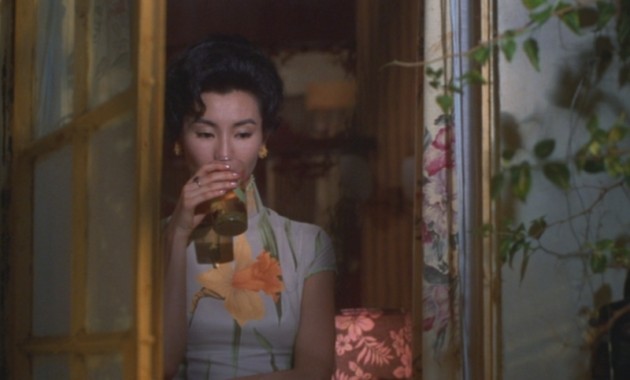
Framed within frames
The tricot of the cinematography, mise-en-scene and modern narrative style makes In the Mood for Love a powerful film, especially when they are combined with the uncanny grace of the musical sound track. The directors of photography, Christopher Doyle and Mark Lee, use camera techniques that perfectly express the feeling of nostalgic closure as intended in Wong Kar-wai’s original script. The use of shot size mostly varies in the range from medium long to close-up, where they repeatedly frame Mrs. Chan (Maggie Cheung) in medium-long to medium shots against dark clashing backgrounds. They often utilize close-ups of ordinary objects or body parts, things that normally go unnoticed and whose significance do not distract from the thematic mood of the painterly mise-en-scenes. These inconspicuous articles are often used as focal references for the overall compositional construction of the shots, an example of this mediating technique is the light switch in the hallway at the apartment house. This unnoticed object becomes a frequent focusing point in many shots and as its color design is made to change from shot-to-shot, it helps to generate an atmosphere of transfixed time. The changes in the art design of such banal elements are indications of the world transformations that occur in time and space. The production designer, William Chang, contributes to the creation of sets that bring us back to 1962 Hong Kong.
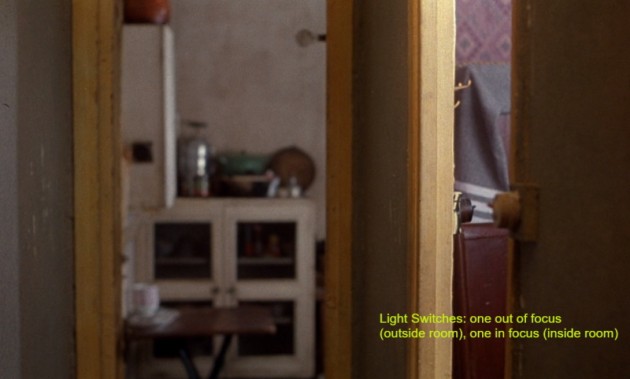
Light switches
The musical score makes In the Mood for Love into a jaded object of desire; a fetishistic longing for the past that is heartfelt in Shigeru Umebayashi’s silky sad waltz. The recurrent sound of this sensual theme is masterly arranged into a “pizzicato” by Mike Galasso, whose haunting string interludes pervade the deliberate slow-motion movements and time-images of the mood; especially important is the repeated three-note plucked string progressions which act like the ticktock of a clock, a signifier that the couple’s heightened emotional sensations are deeply rooted in time as the present fades into the past. There is a sense of transience, a major theme and driving force in both the camera style and narrative strategy, and it seems to permeate the mood of the film both through its objects and memories. In addition, the feeling of uncertainty with all its associated ambiguities is embedded in three Nat King Cole selections sung in Spanish, yet not just a generic Latin rendering but Argentinean Spanish. This fact is key in the evaluation of the film because it defines the threshold condition of a romantically displaced unmoored couple, as the camera transfigures the brilliantine look of Mr. Chow Mo-wan (Tony Leung) and the Platonic figure of Mrs. Chan’s body; and thus, the idea of an American icon singing in a non-native language – “Quizas, Quizas, Quizas,” totally breaks down the feeling of presence and permanence.
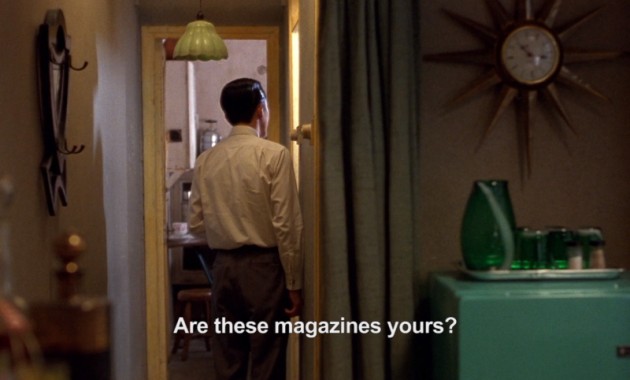
Star shaped clock
Lastly, the costume design is another major point in the criticism of the film. Mrs. Chan’s wardrobe of cheongsam garments is a magnificent display of allusive sensuousness, clothing rendered in a myriad of period fabrics from silk Shantung to psychedelic designs. It is a cinematic way to carry the impact of the passage of time. The shots of Mrs. Chan in her cheongsam outfits are true time-images because they function with elliptical stealth; and if careful attention is paid to watching her dresses, it is easy to see that a change from blue to red or green signals the passage of days, weeks, and even months. This is another of Wong’s mise-en-scene strategies and is used to convey the feeling of transfigured time through the look of objects of the mise-en-scene.
In terms of a narrative description, In the Mood for Love expands on an uncertain love affair and attempts to re-enact the reactions of the couple to the infidelities of their respective partners. However, the narrative has a conservative facade that is not ambiguous because there exists a strong moral restraint on the part of its characters.
After delineating the “dream-memory” and “transfigured-time” characteristics of In the Mood for Love, a descriptive discussion of its main sequences will enable us to identify the varied repetitive patterns that propagate through it. Wong Kar-wai’s style of filmmaking is well defined and traceable within the film, conveying an interiorized landscape of desire as memory.
In the Mood for Love is a successful film because its formal elements unite without any hint at its motifs going astray. It achieves the goals set by the melodramatic themes of moral restraint, social politeness and cultural nostalgia. The film begins unconventionally with a black screen as we hear the sounds of old style, five-note scale Chinese music and voice (possibly Mandarin), immediately followed by the subtitle: “Eat up, enjoy yourself.” Next, the first visible shot is presented as the camera pans left at medium speed across a wall holding up a horizontal row of photographs, all Chinese women; then the subtitle “The fish is very fresh today” is seen on the screen. The reference to the enjoyment of food immediately conjures up the social rituals of the feast, which can be seen as specialized forms of worship. In the Mood for Love is not only a lost moment in time but also a ritualistic worship of an irrepresentable emotion and sacred feeling, the “mystique of love.”
In the Mood for Love is highly praised because its narrative construction follows the pre-planned structure of Chinese serial martial arts literature, where the film’s plot appears to be broken down into intersecting chapters, crossing one another as the story unfolds. The evidence for this seriality and intersection motif is presented through the character of Mr. Chow who devotes much of his spare time at writing serial martial arts novella; and that is why, many of the hallway scenes are repetitiously varied. Let’s give some examples.
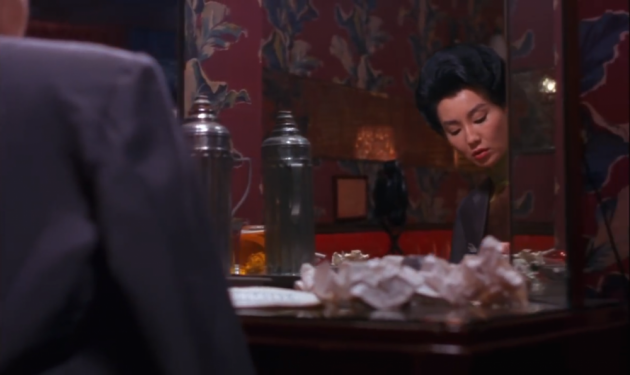
Mrs. Chow writing
Consider the opening sequence that involves the renting of the rooms at the apartment house. Mrs. Chan has just rented the last room from Mrs. Suen who is seeing her out. There is a straight cut to a man climbing up the stairway, it is Mr. Chow who is shot in the shadows where only a small greenish brown spot on right side of the wall is lit. As he reaches the corner turning point in the stairway, Mr. Chow stands in front of the background wall which is lit from above, all the rest of the frame is mostly in the dark. This shot is one of many in which the frame-within-a-frame technique is used. As Mr. Chow leaves the left side of the frame climbing to the apartment hallway at the top of the stairs, he blocks most of the light, as the shot grows darker. A straight cut follows to an out-of-focus, extreme close-up of a light ceiling globe as the camera zooms-out and pans downward, coming into focus in medium close-up on Mr. Chow, who is dressed in a bluish suit-and-tie outfit with a brilliantine hair style.
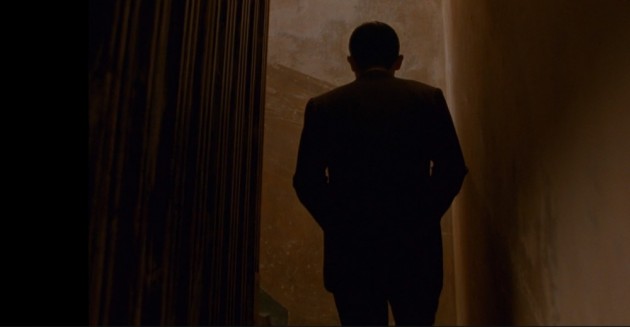
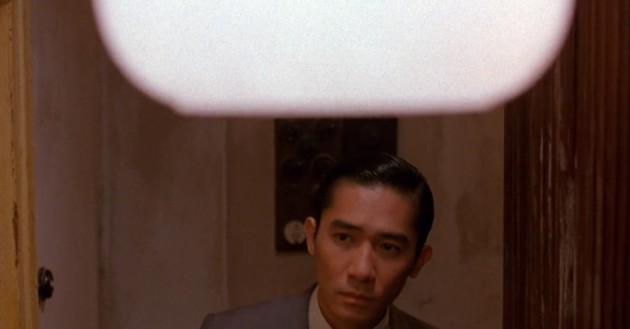
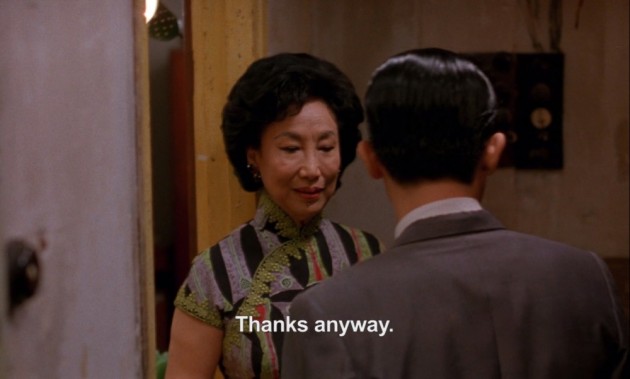
The “northern lighting” creates a marked glow on the top of his head (recalling a famous Josef von Sternberg lighting technique). A long lens is used because the greenish brown background wall falls out-of-focus. Mr. Chow moves forward toward the camera into close-up as he goes out-of-focus in the right side foreground. This kind of camera style gives a sense of impermanence and transiency to the scene. The following dialogue is heard: “So, it’s agreed then,” “Thank you very much, I should go,” “Fine,” “Bye,” Take care, goodbye.” The camera pans left to an oblique view of a yellow framed doorway where Mrs. Suen is seen slightly out of the doorway, only half her face and chest can be seen. Mrs. Chan is framed in focus between the other two, in the center middle ground which is well lit from the left side where Mrs. Suen stands below a light bulb. Mrs. Chan fully turns around, facing away from the camera, and begins to walk down the stairway. She disappears from the right side of the frame, leaving Mrs. Suen and Mr. Chow momentarily alone in their respective positions. Such camera pauses are marked characteristics of Wong’s postmodern style and they are interspersed throughout the film, especially of shots with no characters. A straight cut onto Mr. Chow follows, the camera crossing the 180 axis, he is shot in medium close-up focus as he moves forward toward the doorway with the background out-of-focus. The dialogue begins: “You’ve a room to let?” “Sorry, it’s just been rented to that lady.” A straight cut back across the 180 axis to the previous camera position and the same oblique view of the yellow trimmed doorway follows, but now Mrs. Suen has stepped out into the hallway. Her beautiful cheongsam can be seen with its black and silvery striped patterns and greenish trim designs on the short-arm sleeves whose similar pattern crosses her chest wrapping around her cylindrical collar. Now, Mr. Chow and Mrs. Suen are facing each other, standing in the hallway. Mr. Chow is slightly out-of-focus in the right side foreground of the frame with his back to the camera. Mrs. Suen is framed in-focus at the center of the middle ground at an oblique angle relative to the camera. The word “Thanks” is heard. A key detail to Wong Kar-wai’s camera style is seen at this point where the characters’ heads are framed in such a manner as they seem interconnected within the frame.
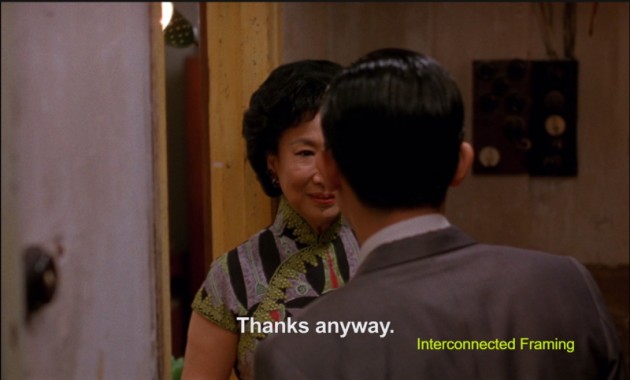
Interconnected framing
This intimate framing pattern is seen throughout the film when emotional closeness is involved. Their heads move together in such a way that Mr. Chow’s head cover half of Mrs. Suen’s face, his ear blocking the view of her nose. Now, Mr. Chow moves forward toward Mrs. Suen and away from the camera, as though he is getting ready to go down the stairway; but he stops near her and turns to look at her face. Mrs. Suen stands facing him but does not immediately look at him in the eyes, instead she momentarily stares at his chest and then she raises her eyes to look at his and says: “How many?” Again, this kind of pausing (this time by the actors’ eyes) is a subtle but significant stylistic element in Wong’s modern mise-en-scene construction. A straight cut again, back across the 180 axis, to the same camera position of the previous shot, defines these tight vertically composed shots (previously mentioned). As before, Mr. Chow is shot in close-up standing in front of Mrs. Suen who is located adjacent to the doorway. The dialogue begins again: “Just me and my wife,” “why don’t you try next door,” “They’ve a vacant room too?” “Yes, Mr. Koo’s son got married.” A noticeable Viscontian immersion exists in both the dialogue and ambiance of this scene, bringing the shots beyond the “movement-image” and into the domain of the “time-image” (a term define by Gilles Deleuze in Cinema 2: The Time-Image), creating the contemplative tone of this urban fantasia. At which point, there is another straight cut back across the 180 axis to the previous identical camera angle. Without going any further with this particular scene description, it can be said that this camera style is typical throughout the film. Another example will concretize this point. But before proceeding, In the Mood for Love exhibits serial novella attributes, which are not only defined in their operetta-like characterizations but also in their narrative compositional structures, because many of its sequences end in long fades to black screen, an indication of chaptered construction.
Consider the second sequence that involves the moving-in scenes and the first meeting of Mrs. Chan and Mr. Chow. As the movers hustle back-and-forth through the narrow passageway of the apartment house hallway, the plot picks up the story where Mrs. Chan and Mr. Chow move-in at the same time and as expected, the situations get confused because personal objects get misdirected to the wrong locations. Both protagonists act as moving directors, and in a way, they can be seen as movie directors (another Kar-wai subtlety). These scenes are ones that introduce the audience to the objects that carry power-motif signification in the film, especially mirrors, clocks and magazines. Here a star-shape clock is seen in one of the rooms and Mrs. Chan is worried that the movers will break her precious mirror. The set decor is designed in a bluish green fashion. Mr. Chow is wearing a white shirt and tie while Mrs. Chan is dressed in a dark cheongsam with vertical and horizontal line patterns, creating multiple squarish designs, and Mrs. Suen is clothed with a bright orange cheongsam with a vaguely abstract dragon shape design. The dialogue picks up when Mr. Chow says: “Those books aren’t mine,” “Wrong again?” “Never mind, just leave them there,” “Mind how you hang the mirror it’s fragile.” As the situation unfolds, Mr. Chow is seen with his back turned toward the camera walking down the hallway toward Mrs. Suen’s apartment where Mrs. Chan is rooming. Outside the doorway, he stops and looks inside but Mrs. Chan is not yet in the view of the camera, which is relatively positioned on the right side of the doorway. The encounter begins with a straight cut across the 180 axis with the camera positioned on the left side of the doorway and facing in the opposite direction from the previous point-of-view. He says: “Are these magazines yours?” “Yes, they’re my husband’s,” “He reads Japanese?” “A little, his boss is Japanese,” “How should I address you?” “My husband’s name is Chan.” These last two lines of dialogue are crucial points in the narrative strategies because of their deliberate indirectness and the behavior that Mrs. Chan exhibits in answering the question. All through the film this indirect response motif plays an instrumental role in portraying the aloofness of the characters and their socially constrained behaviors. This scene is the first meeting of the couple and again the camera style takes on the same approach as in the renting sequence, except that this time, it is Mr. Chow who is in-focus in a medium close-up and center framed position in the middle ground; while Mrs. Chan is shot out-of-focus in close-up with no prominent lighting, she is positioned in the left foreground of the frame. Her out-of-focus position, as was Mr. Chow’s in the previous sequence, creates a compositional inversion that engenders the feeling incompleteness and impermanence; as though the character is not all there or is somewhere else, somewhere in history for instance. Such inverted compositions pose questions concerning the nature of historical periodicity and transformation, as well as their connections to the lives of people.
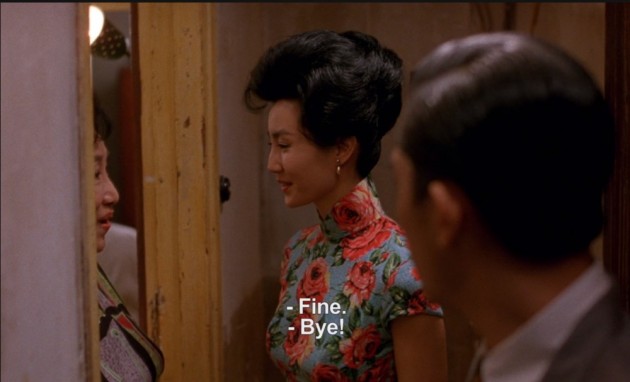
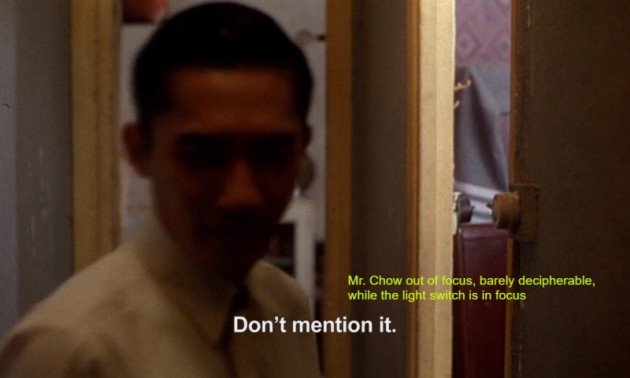
The rhythmic languor and slow-motion camera style are concurrent with the passage of time and these aforementioned indefinite shot compositions that flipflop in inversion, all of which illustrate Wong’s filmic approach to the landscape of historical memory. By comparing the shot compositions of these two hallway episodes, we see that the spatial positions and camera imaging qualities of the shots have reversed, here it is Mr. Chow who is centered in focus while before it was Mrs. Chan. This mise-en-scene strategy is another key factor in the narrative development because it shifts the characters in the frame space, a mirror-like inversion interconnecting the protagonists through spatial displacements; and thus, it is another indication of the intersection motif, which is at work in the film and where the inversion acts to intersect or interconnect the various chapters of the story. The scene continues with another straight cut across the 180 axis to a camera position that localizes Mr. Chow in a position similar to the previous shot, looking into the doorway; but in this succeeding one, Mrs. Chan is seen standing in the doorway in-focus facing the camera, and she is well lit from a source coming from a rightward, inside location of Mrs. Suen’s apartment. And again, she is framed within the frame of the doorway (intimate entrapment and social confinement), the same recurring motif of the individual’s compartmentalization in the urban architecture. She is looking directly at Mr. Chow who is not well lit and out-of-focus, with his back turned toward the camera. In this posterior view of Mr. Chow, an important observation is made concerning the light switch on the wall. It was aforementioned that Wong uses a camera technique in which he references the compositional focal point on inconspicuous objects, bringing the actors into focus relative to it. In these hallway scenes, it is the light switch on the wall that becomes a camera fetish, appearing in-focus in many shots. Again, this observation is a prominent stylistic characteristic in Wong’s filmmaking technical repertoire and helps to unify the other elements as it is repeatedly utilized throughout the film. Here, the light switch is out-of-focus and made to look yellowish while in other shots, it takes the look of other colors.
Finally, the last major point is again the framing positions of the actors’ heads. The doorway frames Mrs. Chan in such a way that she is seen over Mr. Chow’s right shoulder. Both their heads are almost in contact in the field-of-view of the camera; and in such tight shots, these creative “time-images” are deliberately introduced to convey a sense of emotionally-based physical contact, without the need of actually touching; thus, the overall mood of the film is a stylistic feeling of haptic-less touching, taken by the point-of-view of the camera, a truly amazing achievement in shot-composition psychology. The sequence ends with Mrs. Chan turning leftward and going back into Mrs. Suen’s apartment while the doorway remains in-focus, and the ghostly shot continues with Mr. Chow turning rightward facing the camera. He is seen in a out-of-focus close-up with his face slightly lit with vague yellowish patterns superimposed onto it; but his facial features are indiscernible here, because the eyes and mouth areas are blackened while only the nose and forehead are strangely illuminated. He moves forward and left across the field-of-view and out-of-frame; and again, the camera pauses momentarily on the empty scene of the deserted hallway. Then there is a long fade to black and the plot moves to the next sequence.
A final note about this lingering shot on the empty space of the hallway; indeed, such a shot marks an important quality in Wong’s film style because it treats space as a virtual main character in the film. He utilizes such empty shots and their spatio-temporal conditions to outline the couple’s hasty romance from rainy disjointed incidents, slow motion rhythmic descents and ascents from the alleyway of the noodle house, and the disembodied tracking shots in the concluding sequence where Mr. Chow caps the final mood of the film. Such aesthetics are not coincidental because the film carries two ideas that give it life, the emotion of “love” and the feeling of “mood,” which are expressed primarily through non-verbal audiovisual signs [Deleuze’s opsigns and sonsigns] (Deleuze 25). In the Mood for Love is filled with major pauses and silences, creating a minimalist condition that seems to extend into a form of filmic asceticism, representing an almost complete denial of the “action-image” in favor of the purely optical situations. In the Mood for Love has compositional image characteristics akin to the ones found in Yasuyiro Ozu’s Tokyo Story (1953), where it too uses empty shots of narrow closed up spaces.
Even though there is a sadness of regret in the film’s ending, the narrow nighttime passages and claustrophobic hallway scenes open up in time, 1966, a period of no regret (for The Times They Are A-Changin’ … Bob Dylan 1964) when the anti-colonial rioting began in Hong Kong. Mr. Chow is now a journalist working out of Singapore. After a visit to his former Hong Kong residence, the apartment house where he met Mrs. Chan, and the realization that time has transformed itself into another period of history, forever changing both himself and his beloved; he goes on assignment to Phnom Penh to cover General de Gaulle’s visit to Cambodia. The final worship shots at Angkor Wat, a 12th century Buddhist complex, are timeless repetitions of ritualistic acts performed by countless travelers who have passed through this microcosm of the universe. Not only has time changed but also the space itself has transformed because now, there is a different mood and the end of In the Mood for Love signals the viewer to a change of consciousness. Now, the transfigured mood suggests that the monumental imprints left by history, even though superhumanly significant they may be, cannot compare to the essential substances and spiritual nature of the incidental events in the life of a human being. The narrow passages of the alleys and hallways have become the tropes for Mr. Chow’s labyrinthine state of mind, a consciousness that is finally being subjected to the act of forgetting; and his act of psychic regurgitation is an attempt at the dissolution of regretful memories, remembrances that he can see but cannot touch. Time becomes the mouth of a huge river flowing into the ocean of eternity while the cramped spaces of Hong Kong have relaxed into daytime; and now outside gliding shots are seen to flow with time itself, and across the deteriorated temple structures and deep untended gardens of Angkor Wat.
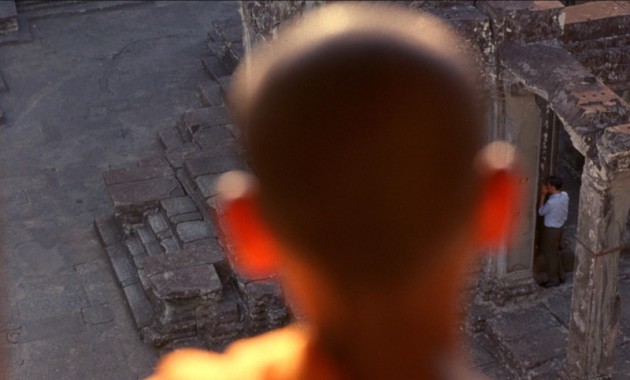
In a posterior view, the back of the head of a Buddhist monk is seen in an out-of-focus, foreground composition, with its fuzzy orange shadow blotting out part of the frame, as Mr. Chow transfixes time and space with a mood of secrecy; but at the same time, there is a feeling of release, the letting go of past desires that were not and could not ever be fulfilled. In this deserted location where time stretches back centuries, Mr. Chow achieves a mood that may be akin to nirvana, a feeling that is neither happy nor sad; but a mindfulness (Hinayana Buddhism’s goal of enlightenment) of the facts that life is a wheel that entraps its weary passengers in a web of desires and hopes. It is like a dream that one must eventually wake up from and the realization that the true power of love is its magnificent spiritual mood for compassion, the human tenderness to understand the uncommitted nature of others and the self-reluctance of ones own needs, especially the need for love.
The critical evaluation of Wong Kar-wai’s In the Mood for Love is based on careful literary considerations within a cinematic formal system of postmodern practices. It achieves its narrative goals by precise patterning and use of unified elements. The film is simultaneously a dream-memory and a process of transfigured-time. It possesses the feeling of a soap opera set within Chinese culture and follows certain social norms. It also conjures up the look of a social ritual in which the protagonists are players on the theatrical wheel of life. At times, it is both funny but sad and exhibits definite signs of a melodrama. The mood of the film swings between high and low and across a complete generational time period. It is initially squeezed within cramped urban locations but expands to an open countryside setting by the end of the film. Memory and forgetting seems to pervade its main theme and the other elements that compose it. In the Mood for Love is a masterpiece of postmodern storytelling.
Selected Bibliography
Bordwell, David and Kristin Thompson. Film Art: An Introduction. Fourth Edition. New York: McGraw-Hill, 1993, pp. 391 – 396.
Deleuze, Gilles. Cinema 2: The Time-Image. Minneapolis: University of Minnesota Press, 1989, pp. 1 – 43.
Teo, Stephen. Hong Kong Cinema: The Extra Dimensions. London: BFI, 1997.
Teo, Stephen. Wong Kar-Wai: Auteur of Time (World Directors). London: BFI Publishing, January 11, 2005.
Teo, Stephen. “Wong Kar-wai’s In the Mood for Love: Like a Ritual in Transfigured Time.” Senses of Cinema. April 2001, Issue 13, pp. 1 – 7.

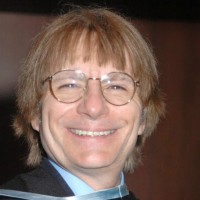

Godzilla,_King_of_the_Monsters-small_400_258_90_s_c1.jpg)
